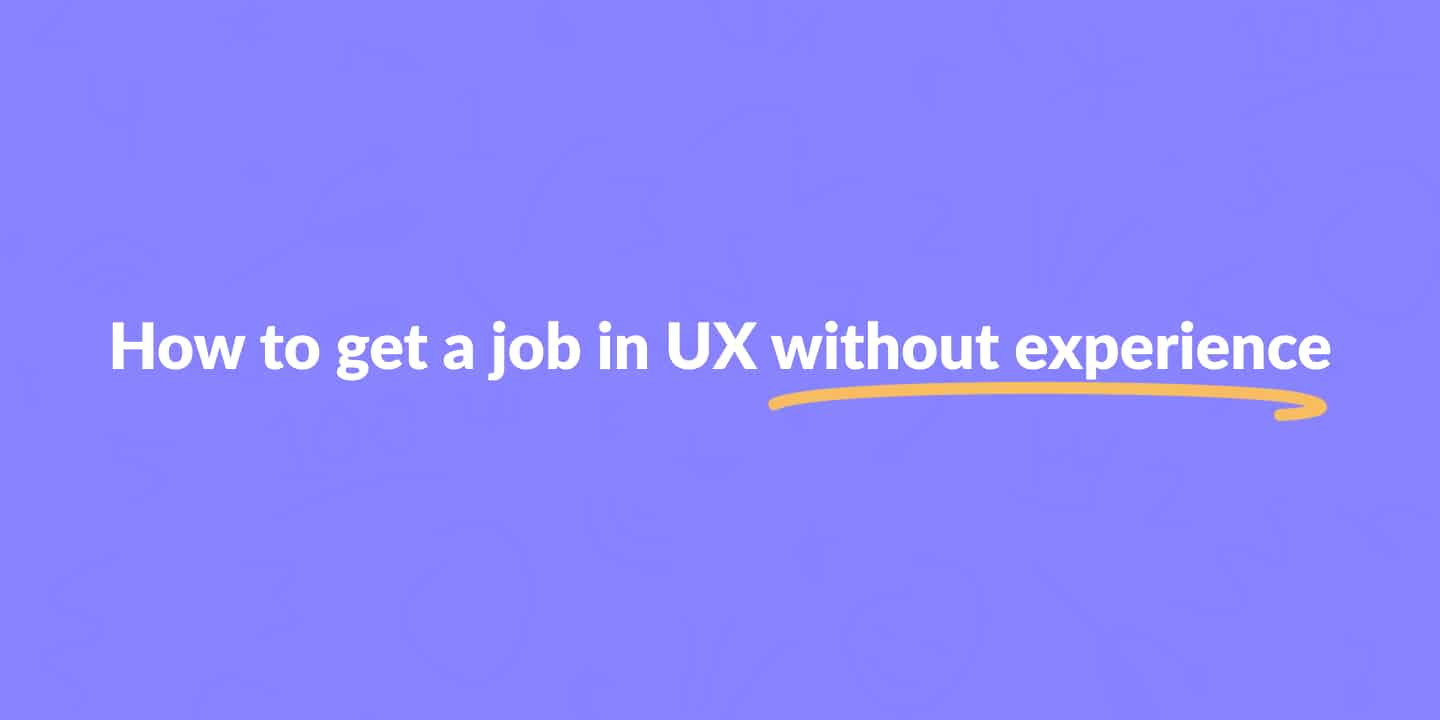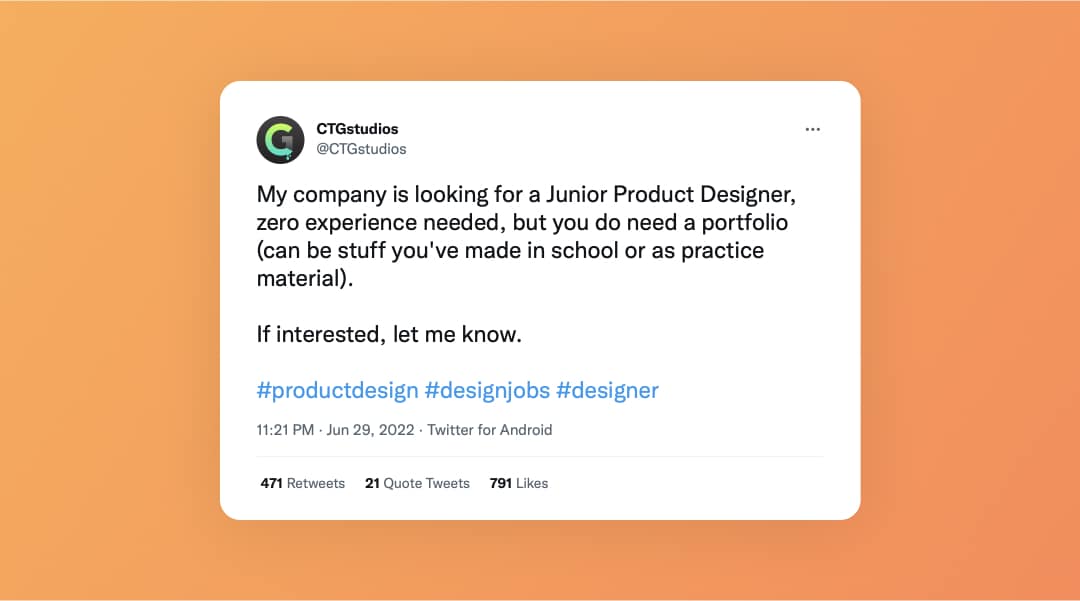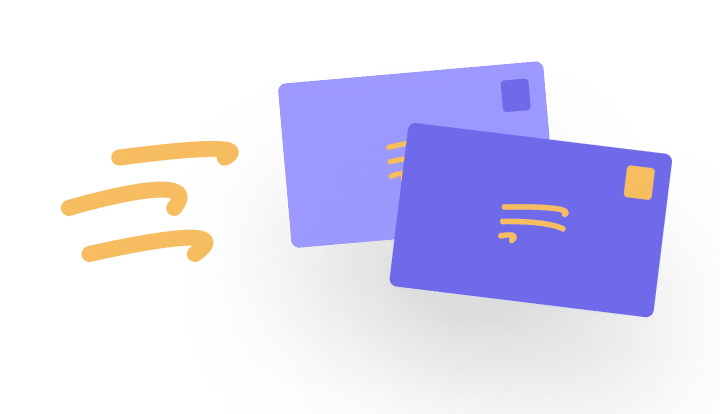How would you go about getting a job in UX without experience? Imagine finishing your UX education and then starting your UX job hunt. After a while, the rejections start coming in. Sadly, most rejections are the same and say that you lack experience. That’s not helpful feedback at all! In this article, I will help you learn how to get a job in UX without experience.
- Updated on January 3, 2024

Getting a job in UX can be challenging. It is even more so the case when you have no experience yet. You have multiple projects and certifications in your UX portfolio. Yet, you still get rejection after rejection due to a lack of professional experience. That’s tough!
There’s a way to get hired, though! Here’s how to get a job in UX without experience.
Table of Contents
Why is it so hard to get a UX job?
I want to start by saying that it is not your fault that you did not get a job in UX just yet. Here’s why.
There are more entry-level designers than there are entry-level jobs. As a result, companies can be picky. For example, if ten people go for the same job opening, the company can pick the candidate with the most experience.
The problem is that companies are starting to expect that extra experience now. We’ve all seen those job openings where a company requires five years of working experience for a junior role.
It is a big problem for entry-level designers. But that doesn’t mean you shouldn’t try.
How to get a job in UX with no experience
To get a job in UX with no experience, you have to get experience another way. It is a simple answer. But that doesn’t mean getting a job is easy. It most certainly isn’t.
Sure, you could be lucky enough to know someone who has a way in for you, or you could follow many UX courses to increase your chances.
But the simple truth is that real-world experience will do more for you than almost everything else you have in your portfolio.
So, the objective is simple. To get a job in UX without experience, you need to find another way to get (some) experience.
Luckily, you can do that in several ways that are fun to do, great for your career, and in some cases, will even get you an income. Let’s look at these ways now.
Volunteer
The first way to get experience as a UX designer is to volunteer. For example, you can do great work for charities and hackathons.
Another example of volunteering as a UX designer is facilitating workshops. That’s a valuable skill to have for any UX professional!
Do enough volunteer UX projects, and you’ll build a great UX portfolio and a strong network. But more on networking later.
First, let’s talk some more about volunteering and how to do it. Of course, the biggest advantage for a client is that the client doesn’t have to pay you.
However, money is only one thing. Because even though it wouldn’t cost the client money, he still has to invest time in you. And investing time is just as valuable.
You have to prepare a good story to convince the client to invest his time in you.
How to get a volunteer UX project
One of the best ways to get a volunteer UX project is by reviewing someone’s website, product, or service.
Make a list of what you would do differently and send over that list. Keep a few items to yourself and mention how you’d be more than happy to help that person further.
At that point, the client expects you to ask for compensation. Of course, you could try that, but that lowers your chances of getting the job. It is a problem because the client didn’t budget for a random person to offer their services.
Instead, mention how you’d be open to doing the work for free in exchange for a testimonial after completing your project.
That way, it is a win-win situation for both of you. You get experience working as a UX designer, a testimonial, and a network. The client receives awesome work from an awesome designer.
Another way to find UX volunteer projects is by going on UX job boards specifically aimed at volunteering. One example is UX rescue, but there are more.
(Local) freelancing
One of the answers you always get when you ask an experienced UX designer for advice on how to get a job in UX without experience is to freelance.
And yes, I will also include freelancing as one of my answers. But there’s a twist. Offer your services to local businesses instead of online.
Do you know a local restaurant with an outdated website? Here’s your chance to help out. Similar to volunteering, reach out to that local restaurant!
Freelancing for local shops and businesses helped me get my first two UX clients.
One was a local musician, and the other was a pizza place. Both didn’t pay well, but they did help me build my first two UX case studies that weren’t made in school.
How to get your first freelance UX client
You can get your first local freelance UX client by going door-to-door, doing cold outreach, and tapping into your local network.
For example, I knew both clients somewhat before I worked for them. That musician I mentioned earlier lived a few houses down the road, and I ordered food from that pizza place often before.
Offering your services to these local companies goes similar to the volunteering I mentioned earlier. Use the service, write down what works and what doesn’t, and then provide some insights and offer to help them further.
You’d be surprised what can come from that.
You might be wondering why I recommend local freelancing over online freelancing. It is not that I would pick one over the other. Both can work very well to get extra UX working experience.
However, there’s way less competition locally. I’m confident that I’m the only one or one of very few UX designers in my local town of 12,000 inhabitants.
On the other hand, online platforms like Upwork and Fiverr are solid alternatives but have thousands of other designers.
There will always be a designer willing to do the same work for a lot less. You can try, and that’s completely fine, but don’t forget the power of local freelancing.
Personal projects
Up next are personal projects. Your resume and portfolio are essential if you want to get a job in UX. However, there’s one more way you can get valuable experience, and that’s by working on personal projects.
I’m not talking about a project for a fictional client that you later turn into a case study. What I mean is building something for yourself.
For example, I’m building a UX portfolio review service. It helps me learn essential skills like selling your services, designing a landing page, and giving UX feedback on the job.
In addition, it earns me some extra money. That’s always a good thing while you continue your job hunt. I can highly recommend working on a personal project of your own. It can be anything UX-related.
What’s the worst that can happen? Even if there’s no interest in your project, you can still write about your experience and what you’ve learned and build a network while doing it.
Networking
The final way to help you get hired in UX without experience is networking. It is, in fact, the most important one on this list because it is an essential part of every other item on that list.
But how to network as a UX designer? First of all, network as much as you can. Find (local) events, join a Slack UX community, or start engaging with other accounts on social media. Start today!
Once you’re at the networking event, don’t ask for a job immediately. You don’t want to be that sales guy everybody avoids. Instead, be seriously interested in other designers’ projects and what they’re up to.
Be curious, but also make sure people know who you are and what you can do. Then, what happens is that these people will remember you when they’re looking for someone with your skill set.
That’s why you need a great pitch, by the way. So work on that!
How to network as a UX designer on social media
Another way of networking is to become active on platforms like Twitter and LinkedIn. For example, LinkedIn has excellent UX groups, like the User Experience and Figma groups.
The same networking rules apply on social media. Be active, make sure people know what you can do, but don’t come across as very sales oriented.
You can stand out from the crowd by commenting and posting more than the average comment. Instead of just saying ‘nice’ or ‘interested,’ provide some actual feedback. Ask a question and provide value to the community.
That last one is especially important when looking for a job. Many people will only say ‘I’m available or ‘interested.’ You can make a great first impression by directly reaching out to that person.
One of my colleagues once wrote an entire blog post on how his experience ordering something at a local hardware store was far below par.
He tagged them in his post and mentioned several ways to improve that store’s user experience.
The post went semi-viral, and the hardware store reached out to my colleague and hired him to help them solve their UX problems. It is an excellent example of how networking can help you get experience as a UX designer.
Other things to keep in mind
When you want to get a job in UX, it is easy to say that lack of experience is at fault. It is even easier when most companies mention your lack of experience as their reason for rejecting you.
However, there are several other factors at play.
Maybe you have the required working experience, but you need to write and present it better. It could be the state of the job market or just bad luck.
To help you increase your chances of getting a job in UX without experience, I’m going to dig a little deeper to look at the other factors at play.
Why are there no junior UX jobs?
First up is the UX job market. In general, the UX job market is booming. For example, if you compare Glassdoor’s top US jobs of 2021 and 2022, you see that there are far more UX job openings in 2022 in the US than there were in 2021.
That’s a good thing when looking at your options for 2024! However, the number of people moving into UX is also growing.
There are more entry-level UX designers than entry-level jobs. Because of that, companies can be (too) picky. I mentioned something about that at the beginning of this post.
You can see this situation at play when a company mentions they have an actual junior UX job opening. The tweet below is an excellent example.

At the end of June, CTG Studios was looking for a junior product designer with no working experience required. Within 24 hours, over a hundred people replied.
Today, at the moment of writing, the tweet has been retweeted over 400 times. CTG Studios even mentioned how they were overwhelmed by the number of responses they’ve received.
It is challenging for an entry-level designer to get a job. As I mentioned earlier, companies are asking for a lot of experience because they can. Because of that, there are hardly any junior UX jobs, which is a huge problem!
How to present your UX portfolio
When you get a rejection letter stating that you don’t have the experience, it might also be that the hiring manager just didn’t understand your work. Unfortunately, it is something that happened to me far too often.
In that case, the biggest boost you can give your UX job hunt is to improve how you write your case studies.
After reviewing many case studies and portfolios, I can honestly say that the best way to improve your case study is to make them shorter.
Looking at how most UX bootcamps teach you how to write case studies, you’ll see that the outline almost feels endless. It is a lot of ‘and then I did this.’
In most cases, one crucial section is missing, and that’s the conclusion. In that paragraph, you mention how your work has impacted your client.
In other words, what problem have you solved, and how does that help your client’s user and business goals?
How to improve your case studies
Here’s my step-by-step approach to building better case studies.
Start with a summary that is only one paragraph long. Here’s what to include. You can use this summary on LinkedIn as well as your resume.
- Your job
- The client
- What you did
- The results
From here, write one or two paragraphs for each item on the list above. In total, you should have about 5-8 paragraphs now.
Until now, this is only text. No need to add visuals. Focus on the content for now!
Once satisfied with the result, it is time to add your case study to your website. You can add your featured image and other visuals from this point forward.
I have a UX case study template that teaches you exactly how to write a case study that is to the point and helps you stand out among your entry-level peers. This is more important than ever given the number of other people looking for the same jobs.
Apply for less junior UX jobs
Another thing to remember is the number of UX jobs you apply for. Most people would recommend you to apply for as many jobs as possible. It is a numbers game, after all.
In a way, they are right. The more you apply, the more likely you will find a job that suits you.
However, this strategy of getting a job in UX also comes with many rejections. And that’s terrible!
What I would recommend instead is to apply less. Take your time to research UX job openings. Is the company in an industry you see yourself working in? Do you have most of the requirements?
If you answered yes on both, then go and apply. Otherwise, don’t. It’ll save you a lot of time and many rejections.
What to expect
And finally, something about what you can expect during the job hunt. Looking for a job in UX can be challenging. It will most certainly take some time.
When I speak to entry-level designers, I can’t help but notice that a large group expects to find a job within weeks. Sadly, this is not the case.
In today’s job market, with many people moving into UX, it can take months to get your first job in UX.
When I started my UX career in 2015, it took me eight months to get my first job even though I had a degree, four years of university, and a portfolio full of freelance UX work.
You need to be patient. That would help you so much. Getting a job in UX without experience will take months of hard work and a lot of networking. But getting that job will be worth it if you can do that.
Next steps
I can understand if you feel somewhat overwhelmed with all the information and things to do mentioned in this article.
Are you stuck in your UX job hunt? Are companies telling you that you do not have enough experience in UX? Here’s what to do next.
Start with networking. Out of all suggestions, it takes the longest before yielding any results. So start today by joining relevant LinkedIn groups.
After that, start by looking up local businesses in your area. Reach out to them and offer your UX services.
Once you’ve taken the two steps above, it is time to start rewriting your case studies. Again, use my UX case study template if you want.
That’s it. This should help you get a job in UX even when you don’t have any prior work experience in UX. Good luck!

About the author
Hi! I'm Nick Groeneveld, a senior designer from the Netherlands with experience in UX, visual design, and research. I'm a UX coach that supports other designers and have completed design projects in finance, tech, and the public sector.
☎️ Book a 1:1 mentor meeting or let's connect on LinkedIn and Twitter.



